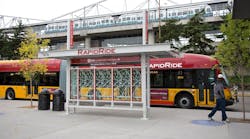OP-ED: The $39 billion Gateway Tunnel project, yesterday, today and tomorrow
On June 11, the Federal Transit Administration’s (FTA) Acting Administrator Veronica Vanterpool sent an official 15-day notification letter to Congress for her intent to execute a $6.88 billion Capital Investment Grant (CIG) New Starts Full Funding Grant Agreement (FFGA) to the Gateway Development Commission (GDC) for design and construction of the $16.1 billion Gateway Tunnel Phase One project. This represents the largest FFGA in FTA's history.
The GDC is on the hook to cover costs beyond the agreed upon project budget. The federal share is capped at $6.88 billion. The GDC has no financial resources of its own. It would have to turn to Amtrak, New Jersey Transit (NJ Transit), New Jersey Thruway Authority, Port Authority of New York and New Jersey (PANYNJ) and the states of New Jersey and New York to cover the inevitable cost overruns. New Jersey motorists could end up paying increased tolls on PANYNJ bridges, tunnels and NJ Turnpike. This is on top of potential future New York Metropolitan Transportation Authority (MTA) congestion pricing tolls to enter Manhattan below 60th St.
NJ Transit riders might face fare increases. GDC, on behalf of Amtrak and NJ Transit, have to meet a revenue service date of November 2040 or earlier. The states of New Jersey and New York and the PANYNJ are responsible to pay back three United States Department of Transportation (USDOT) Railroad, Rehabilitation and Improvement loans worth $3 billion. These dollars were counted as part of the project local share.
Many years ago, FTA would not accept other federal agency grants or loans as part of the required matching local share for any CIG FFGA. It was considered "double dipping" of federal funds. The applicant would have to identify funding of its share in an annual budget, approved multi year capital program, dedicated local sales tax, adopted local transportation bond issue or other non federal source(s). Providing local over match above 50 percent against the requested federal share could result in a higher rating as part of the FTA review and ranking of the project. FTA's ability to obligate FFGA's with significant overmatch dollars could sometimes make available funding to approve additional FFGA's for other transit agency projects around the nation.
The approval of this FFGA is part of any administration's fourth year in office. They want to legally bind the next administration into having to fund the project. The Biden Administration, USDOT Secretary Pete Buttigieg, Acting Seretary Vanterpool and U.S. Senate Majority Leader Chuck Schumer (D-NY) are afraid that if Donald Trump wins the presidency in November and Republicans regain control of the Senate and keep control of the House, approval for funding in the FFGA might be held up or reduced.
When I worked in the FTA Region 2 Office serving New York and New Jersey, as director for the Office of Operations and Program Management, we called the fourth quarter (July 1 - September 30) our end of year grant and FFGA clearance sale for approval of grants using lapsing funds or FFGAs. It was also referred to as the Halloween Veterans Day grant cycle.
This was the code word for pre-Election Day grants. FTA did not want to leave any money on the table that the incoming Congress might want to take back or reduce FTA funding. FTA headquarters always coordinates grant and FFGA announcements with the winning transit agency, congressional delegation, governor's office, state and local elected officials prior to official approval. This was so FTA could deliver the "treats" that everyone can take credit for bringing home the transit "bacon."
Remember the FTA CIG FFGA $2.6 billion MTA East Side Access to Grand Central Terminal (now known as Grand Central Madison) for a total cost of $6.3 billion in 2006? By the time this project was completed in 2013, 10 years after the original FFGA agreed upon 2013 completion date, cost grew to $11.8 billion (including $600 million in long term debt service payments). The MTA had to come up with $5.3 billion in additional funding to cover all the cost overruns. The Gateway project is bound to suffer the same fate.
Two new Hudson River tunnels fail to deal with the ongoing increasing service disruptions due to power, signal, track or communications problems on the Northeast Corridor impacting both Amtrak and NJ Transit. Trains are unable to either enter or leave Penn Station.
Billions and decades are needed to bring all Northeast Corridor capital assets up to a state of good repair. Substantial repairs to the two original 110 year old Hudson River tunnel (owned by Amtrak and used by NJ Transit) damaged by Super Storm Sandy in 2012 will not begin until 2036 when the two new tunnels are scheduled to be completed and open for revenue service. Given their age, can they continue to safely function 12 more years before work really begins and 17 more years before work is completed?
Phase One does nothing to increase Penn Station capacity. Phase 2 would have an estimated cost of $22.9 billion. It would bring the total cost of Gateway to $39 billion. The scope of work would include adding four new platforms and eight new tracks, capable of accommodating 12 car trains.
Any detailed budget, funding sources and timetable for implementation of Phase 2 is a decade or more away. You would have to see substantial completion of Phase One, which according to the FFGA has to take place in November 2040 or earlier. Meeting this is dependent upon keeping to the agreed on project base line implementation schedule in the FFGA before major construction for Phase 2 would get under way.
According to a 2023 FTA Project Management Oversight (PMO) Independent Engineering consultant report, the $39 billion Gateway Tunnel project was already two years behind schedule. The report predicts a completion date of 2040. The GDC that same year promised a completion date of 2038.
Creation of the GDC duplicated the work of Amtrak, NJ Transit and PANYNJ experienced staff, who know how to manage both the project, apply for and manage FTA funding. All three operating agencies already have their own experienced engineers, operations, planning, procurement, legal, force account, quality assurance and quality control, financial and civil rights employees necessary to manage this project. Hiring of 40 new GDC staff supplemented by expensive outside consulting firms, engineering companies and lobbyists has only resulted in creation of another bureaucracy duplicating existing transportation agencies and their staff.
GDC was really created to give elected officials political cover. If GDC does well, governors and senators will take credit. If they fail, governors and senators will say they had no control over the agency. This is how the game has been played between the governors of New York and New Jersey when it comes to the PANYNJ.
You have to ask why it took GDC, which was established in July 2019, almost five years working with FTA to receive the CIG FFGA.
There is no guarantee (based upon future advancement of design and engineering, construction contractors responses (bids could come in higher than GDC estimates) to the procurement process for contract(s) awards, notice to proceed, contractor mobilization of employees and materials followed by change orders during construction due to unforeseen site conditions or last minute changes in scope that the final cost could end up billions more than the GDCs Phase One $16.1 billion project cost. In 2015, the estimated cost was $8.7 billion for two new plus rehabilitation of two existing Hudson River tunnels used by Amtrak and NJ Transit for access to Penn Station. The price tag doubled more than nine years to today. The total estimated cost for 100 percent of the proposed Gateway Tunnel project scope of work for both Phases One and Two is $39 billion.
Amtrak providing insufficient track outages for contractor access to some work sites, requests by NJ Transit or Amtrak operations or maintenance groups for additional work could result in added costs. The final price tag might grow beyond $16 billion. It will not be known until 100 percent of all the contract punch list is complete, final contract retainage is paid to all contractors and the last contract is closed out.
The same Amtrak resources are also committed to other projects along the Northeast Corridor, between Washington D.C., and Boston, Mass., for years to come. Three of these in the Metro New York area include the $1.6 billion New Jersey Northeast Corridor Portal Bridge, $3.1 billion MTA Metro-North Rail Road Bronx East Penn Station Access and $1.6 East River Tunnel (connecting Queens to Penn Station).
This does not include ongoing routine maintenance at Penn Station Newark, Penn Station New York, Hudson and East River tunnels used by Long Island Rail Road, NJ Transit, Amtrak and starting some time in 2028 Penn Station by Metro-North Rail Road, $2 billion Maryland Susquehanna River Bridge, $4.7 billion 1.4 mile Baltimore Potomac Tunnel, $827 million Connecticut River Bridge, other stations, tracks, bridges, tunnels, power and facilities along the Northeast Corridor. How can Amtrak provide sufficient numbers of employees to work on these key state of good repair and system expansion projects while supporting work on the Gateway Tunnel project all at the same time?
The Amtrak Inspector General Report on the Portal Bridge project noted that "Amtrak staffing of the project has at times been insufficient." This may be an early warning of problems ahead. The only way to validate that Amtrak has adequate resources, is for an outside independent review of their current 2024 and future Annual Track Outage and Force Account (in house track, signal maintainers and other specialized craft employees) plans.
Amtrak, NJ Transit and Metro-North west of Hudson Port Jervis and Pascack Valley commuters who will benefit by Gateway, potential new riders, taxpayers, public officials and project advocates need to see the executed FTA FFGA with GDC, future FTA Monthly PMO Independent Engineering consultant monthly reports, FTA Trams Transit Grant Award Management System updated Quarterly Financial and Milestone Progress Grant Reports, detailed project budget baseline cost estimate & financial capacity analysis, baseline construction schedule and project management plan.
This information is critical to both understand FTA's justification for investing a record $6.88 billion in CIG funding and to monitor progress for this promised capital improvement. This would meet transparency in the federal government promised by President Biden, USDOT Secretary Buttigieg, New York Gov. Kathy Hochul and New Jersey Gov. Phil Murphy, U.S. Sens. Schumer, Kristen Gillibrand (D-NY), Corey Booker (D-NY) and Bob Melendez (D-NJ).
When it comes to Gateway, Amtrak, NJ Transit, MTA Metro-North Railroad, Port Jervis and Pascack Valley commuters, potential new riders, taxpayers, motorists paying tolls and project advocates deserve nothing less.

Larry Penner
Larry Penner is a transportation advocate, historian and writer who previously served as a former director for the Federal Transit Administration Region 2 New York Office of Operations and Program Management. This included the development, review, approval and oversight for billions in capital projects and programs for New Jersey Transit, New York Metropolitan Transportation Authority, NYC Transit bus, subway and Staten Island Railway, Long Island and Metro North railroads, MTA Bus, NYCDOT Staten Island Ferry along with 30 other transit agencies in New York and New Jersey.






